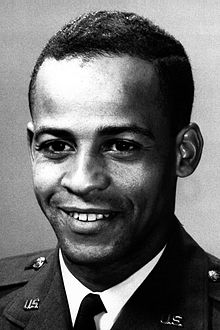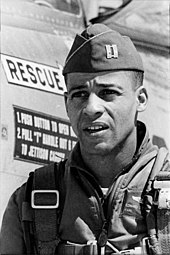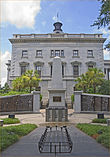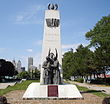
Brigadier General Charles Elwood Yeager was a United States Air Force officer, flying ace, and record-setting test pilot who in October 1947 became the first pilot in history confirmed to have exceeded the speed of sound in level flight.

Edward Higgins White II was an American aeronautical engineer, United States Air Force officer, test pilot, and NASA astronaut. He was a member of the crews of Gemini 4 and Apollo 1.
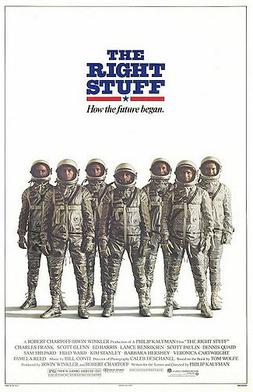
The Right Stuff is a 1983 American epic historical drama film written and directed by Philip Kaufman and based on the 1979 book of the same name by Tom Wolfe. The film follows the Navy, Marine, and Air Force test pilots who were involved in aeronautical research at Edwards Air Force Base, California, as well as the Mercury Seven, the seven military pilots who were selected to be the astronauts for Project Mercury, the first human spaceflight by the United States. The film stars Sam Shepard, Ed Harris, Scott Glenn, Fred Ward, Dennis Quaid, and Barbara Hershey; Levon Helm narrates and plays Air Force test pilot Jack Ridley.

David Randolph Scott is an American retired test pilot and NASA astronaut who was the seventh person to walk on the Moon. Selected as part of the third group of astronauts in 1963, Scott flew to space three times and commanded Apollo 15, the fourth lunar landing; he is one of four surviving Moon walkers and the only living commander of a spacecraft that landed on the Moon.

Guion Stewart Bluford Jr. is an American aerospace engineer, retired United States Air Force (USAF) officer and fighter pilot, and former NASA astronaut, in which capacity he became the first African American to go to space. While assigned to NASA, he remained a USAF officer rising to the rank of colonel. He participated in four Space Shuttle flights between 1983 and 1992. In 1983, as a member of the crew of the Orbiter Challenger on the mission STS-8, he became the first African American in space as well as the second black person in space, after Cuban cosmonaut Arnaldo Tamayo Méndez.
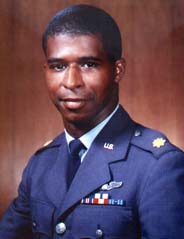
Robert Henry Lawrence Jr. was a United States Air Force officer and the first African-American astronaut.
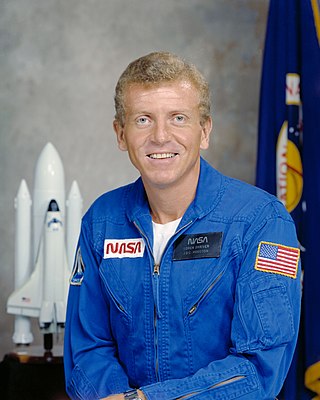
Loren James Shriver is a former NASA astronaut, aviator, and a retired US Air Force Colonel.
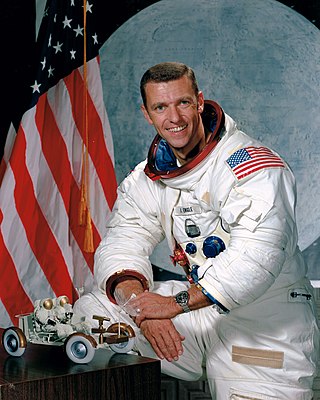
Joe Henry Engle is an American pilot, aeronautical engineer and former NASA astronaut. He was the commander of two Space Shuttle missions including STS-2 in 1981, the program's second orbital flight. He also flew two flights in the Shuttle program's 1977 Approach and Landing Tests. Engle is one of twelve pilots who flew the North American X-15, an experimental spaceplane jointly operated by the Air Force and NASA, and the last surviving test pilot of the aircraft. After Richard H. Truly died in 2024, Engle is now the last surviving crew member of STS-2.
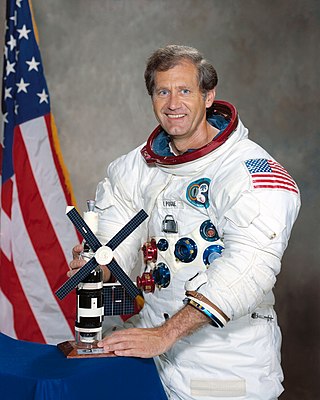
William Reid "Bill" Pogue was an American astronaut and pilot who served in the United States Air Force (USAF) as a fighter pilot and test pilot, and reached the rank of colonel. He was also a teacher, public speaker and author.

Alfred Merrill Worden was an American test pilot, engineer and NASA astronaut who was command module pilot for the Apollo 15 lunar mission in 1971. One of 24 people to have flown to the Moon, he orbited it 74 times in the command module (CM) Endeavour.

The Mercury Seven were the group of seven astronauts selected to fly spacecraft for Project Mercury. They are also referred to as the Original Seven and Astronaut Group 1. Their names were publicly announced by NASA on April 9, 1959: Scott Carpenter, Gordon Cooper, John Glenn, Gus Grissom, Wally Schirra, Alan Shepard, and Deke Slayton. The Mercury Seven created a new profession in the United States, and established the image of the American astronaut for decades to come.

Joseph Albert Walker was an American World War II pilot, experimental physicist, NASA test pilot, and astronaut who was the first person to fly an airplane to space. He was one of twelve pilots who flew the North American X-15, an experimental spaceplane jointly operated by the Air Force and NASA.

NASA Astronaut Group 3—'The Fourteen'—was a group of fourteen astronauts selected by NASA for the Gemini and Apollo program. Their selection was announced in October 1963. Seven were from the United States Air Force, four from the United States Navy, one was from the United States Marine Corps and two were civilians. Four died in training accidents before they could fly in space. All of the surviving ten flew Apollo missions; five also flew Gemini missions. Buzz Aldrin, Alan Bean, Gene Cernan and David Scott walked on the Moon.

Barry Eugene "Butch" Wilmore is a NASA astronaut and United States Navy test pilot. He has had two spaceflights, the first of which was an 11-day Space Shuttle mission in November 2009, to the International Space Station. Wilmore was designated as pilot with five other crew members on Space Shuttle Atlantis for the mission STS-129. He most recently served as part of Expedition 41 to the International Space Station.
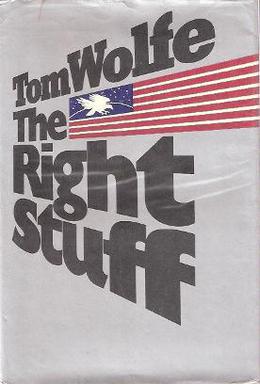
The Right Stuff is a 1979 book by Tom Wolfe about the pilots engaged in U.S. postwar research with experimental rocket-powered, high-speed aircraft as well as documenting the stories of the first astronauts selected for the NASA's Project Mercury program. The Right Stuff is based on extensive research by Wolfe, who interviewed test pilots, the astronauts and their wives, among others. The story contrasts the Mercury Seven and their families with other test pilots such as Chuck Yeager, who was never selected as an astronaut.

Victor Jerome Glover is a NASA astronaut of the class of 2013 and pilot on the first operational flight of the SpaceX Crew Dragon to the International Space Station. Glover is a captain and F/A-18 pilot in the U.S. Navy and is a graduate of the U.S. Air Force Test Pilot School. He was a crew member of Expedition 64, and served as a station systems flight engineer.

Tyler Nicklaus Hague is a United States Space Force colonel and a NASA astronaut of the class of 2013. Selected to be a flight engineer on the International Space Station, his first launch was on Soyuz MS-10, which aborted shortly after take-off on October 11, 2018. His second launch, on March 14, 2019, was successful, taking him and his fellow Soyuz MS-12 crew members to join ISS Expedition 59/60.

Robert Thomas "Bob" Hines Jr. is an American fighter pilot and NASA astronaut.

Raja Jon Vurputoor Chari is an American test pilot and NASA astronaut. He is a graduate of the United States Air Force Academy, Massachusetts Institute of Technology, and U.S. Naval Test Pilot School, and has over 2,000 flying hours. He is a brigadier general in the United States Air Force.

Alice King Chatham was an American sculptor who worked for the United States Air Force, NASA, and their contractors to design helmets, oxygen masks and other personal protective equipment. Equipment she designed was used both on humans and on a variety of animal test subjects.
